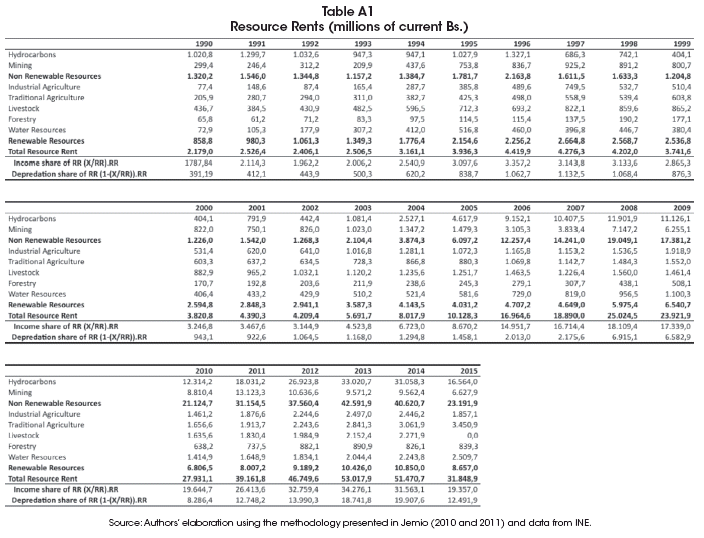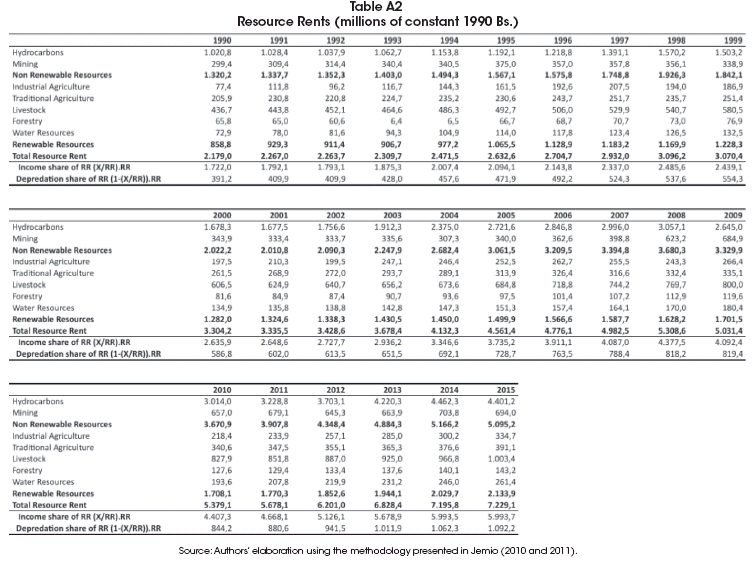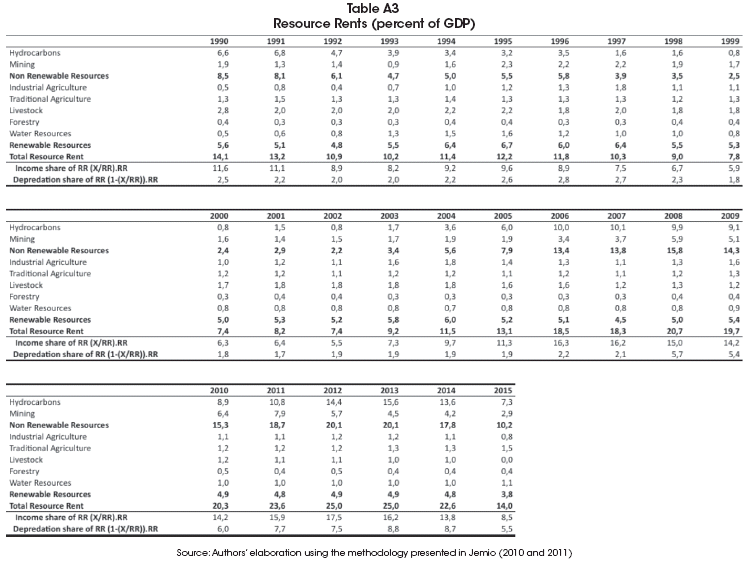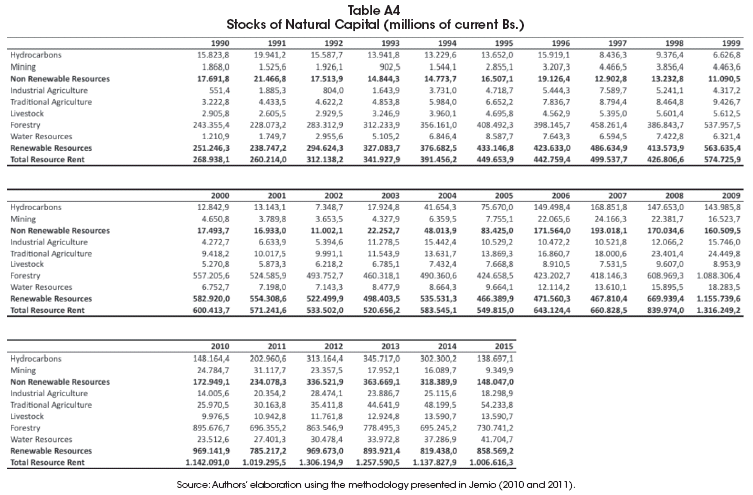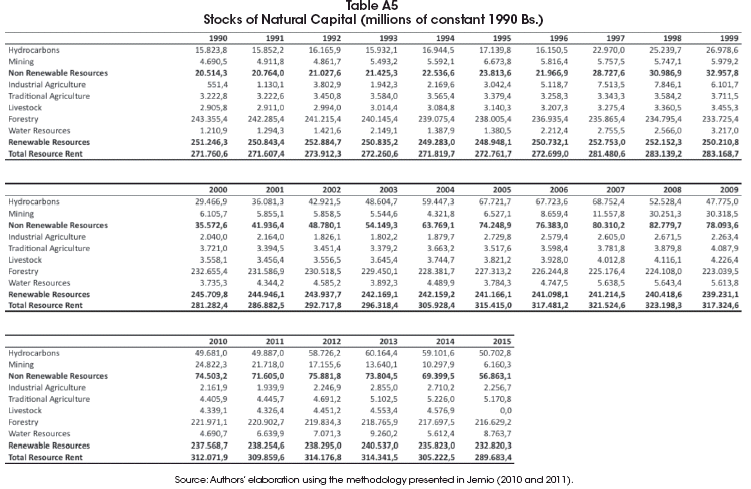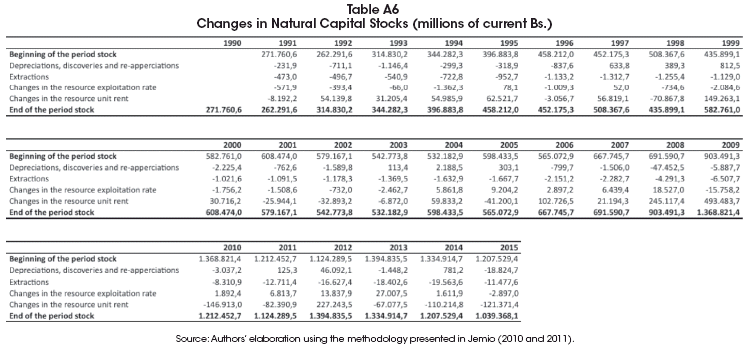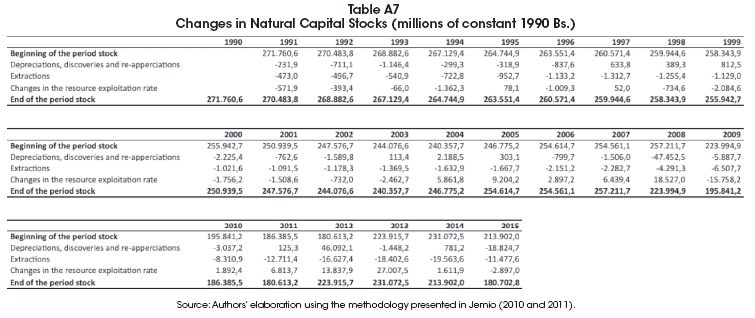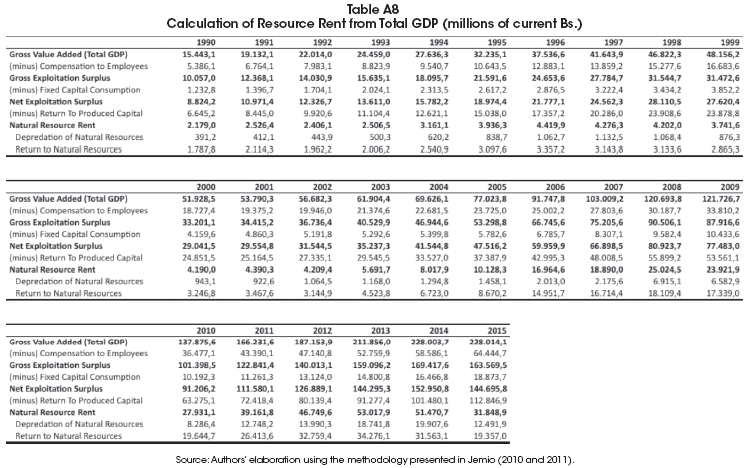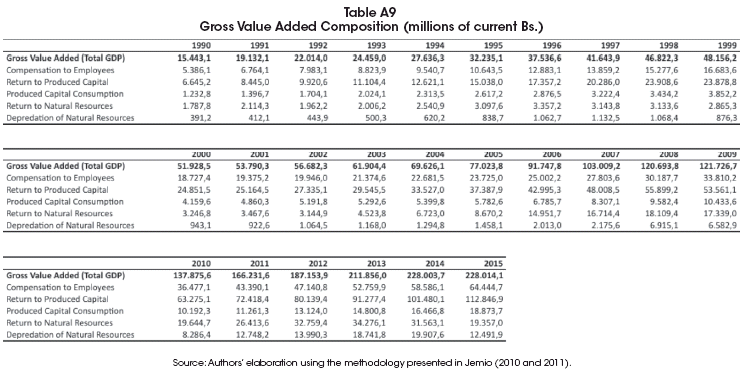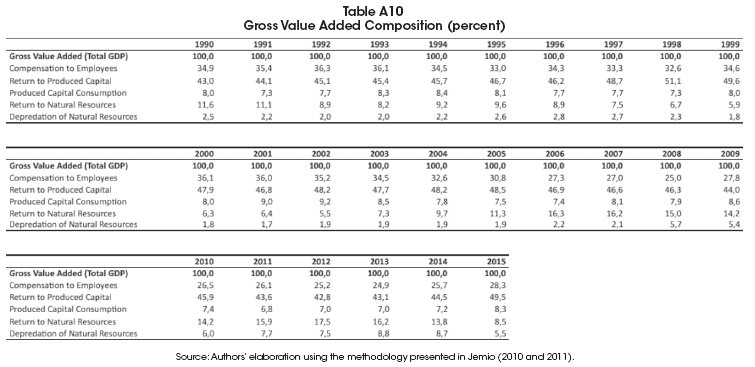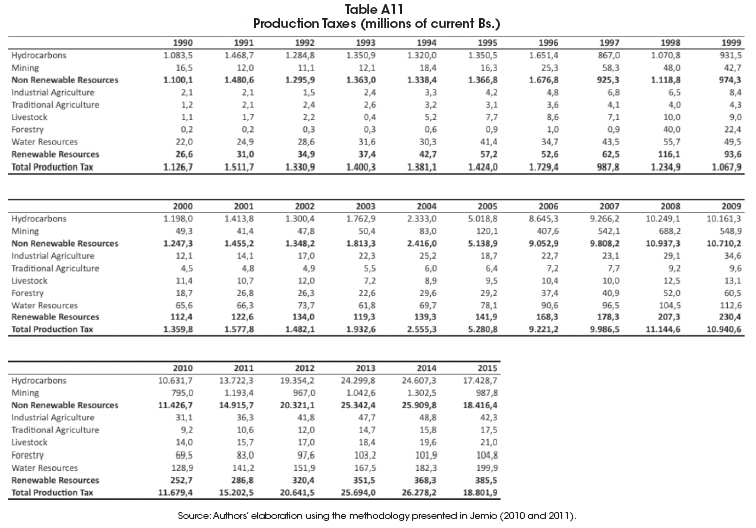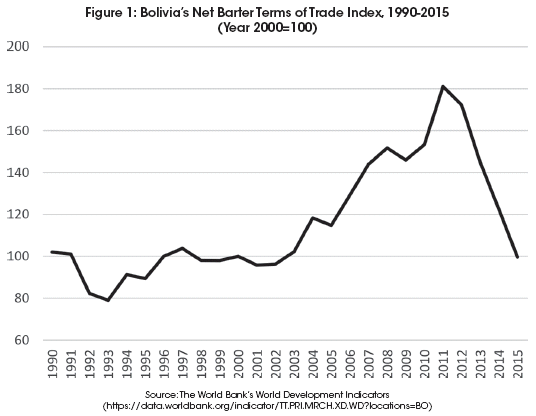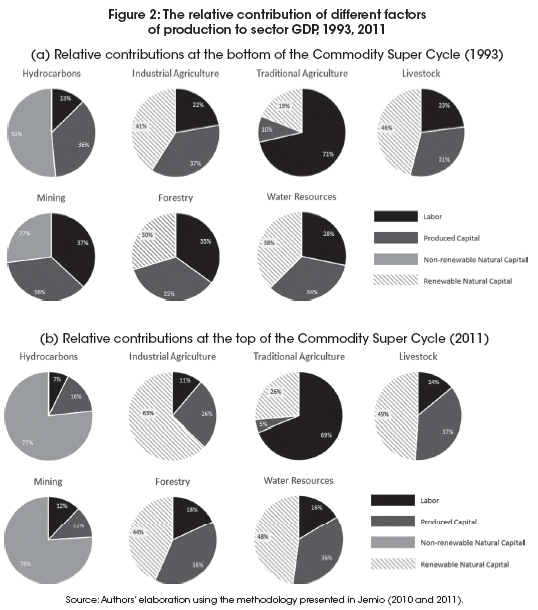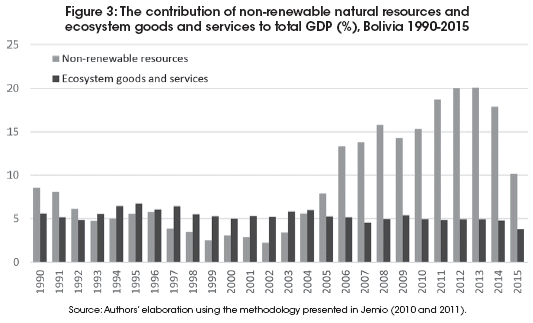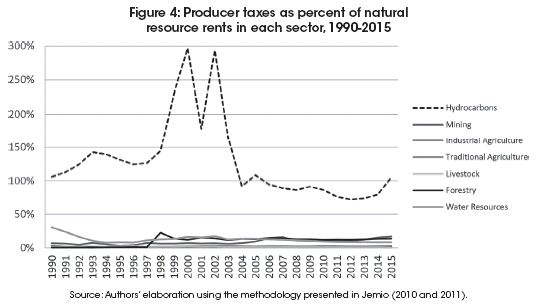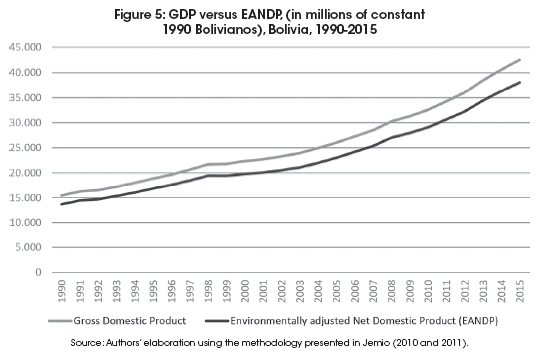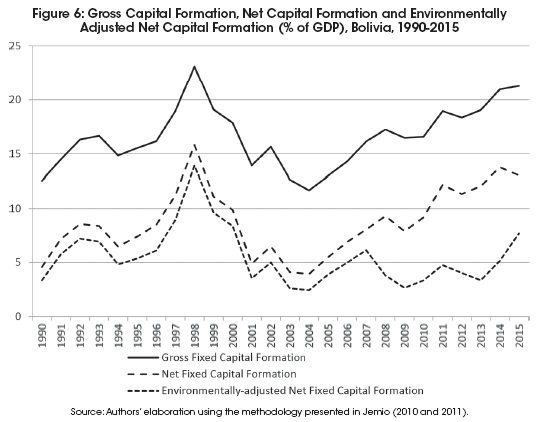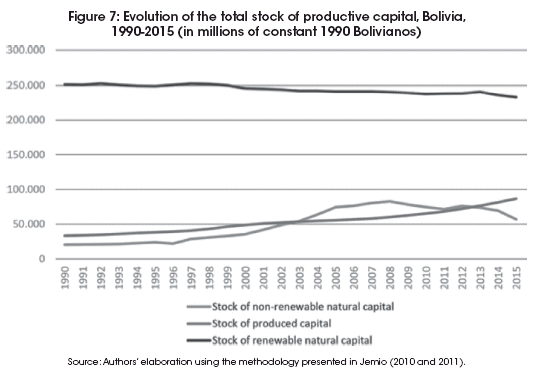Servicios Personalizados
Revista
Articulo
Indicadores
-
 Citado por SciELO
Citado por SciELO -
 Accesos
Accesos
Links relacionados
-
 Similares en
SciELO
Similares en
SciELO
Compartir
Revista Latinoamericana de Desarrollo Económico
versión On-line ISSN 2074-4706
rlde no.29 La Paz mayo 2018
ARTÍCULO CIENTÍFICO
Bolivia's Green National Accounts through a Commodity Super Cycle
Las Cuentas Nacionales Verdes de Bolivia durante un súper ciclo de commodities
Luis Carlos Jemio*, Lykke E. Andersen**, Agnes Medinaceli***
Abstract****
This paper explains the concept of integrated environmental-economic accounts, also called Green National Accounts. It then presents updated results for key indicators from Bolivia's Green National Accounts during the period 1990-2015, which covers an entire Commodity Super Cycle. The first half of this period includes the Great Commodities Depression while the second half is characterized by an unprecedented commodities boom. Results show that the contribution of ecosystem goods and services to the Bolivian economy remain relatively stable over the cycle, while the contribution of non-renewable resources increases by a factor of four between the bottom of the cycle (1993) and the top of the cycle (2011). Similarly, the differences between conventional Net Capital Formation and Environmentally-adjusted Net Capital formation is small at the bottom of the Commodity Super Cycle (2.3% of GDP) but much larger at the top of the cycle (7.7% of GDP). These results were calculated following the United Nation's SEEA 2003 framework.
Keywords: Green Accounting, Natural Resource Rents, Bolivia.
Resumen:
Este documento explica el concepto de cuentas ambientales y económicas integradas, también llamadas cuentas nacionales verdes. Después presenta resultados actualizados para indicadores clave de las Cuentas Nacionales Verdes de Bolivia durante el periodo 1990-2015, el cual cubre un súper ciclo de commodities entero. La primera mitad de este periodo incluye la gran depresión de los commodities mientras que la segunda mitad está caracterizada por un boom de commodities sin precedencia. Los resultados muestran que la contribución de los bienes y servicios de los ecosistemas a la economía boliviana se mantiene relativamente estable durante el ciclo, mientras que la contribución de los recursos no-renovables incrementa por un factor de cuatro entre la parte inferior del ciclo (1993) y la parte superior del ciclo (2011). De forma similar, las diferencias entre la Formación Neta de Capital convencional y la Formación Neta de Capital Ajustado Ambientalmente son pequeñas en la parte inferior del ciclo (2.3% del PIB), pero mucho mayores en la parte superior del ciclo (7.7% del PIB). Estos resultados fueron calculados siguiendo el marco de SEEA 2003 de las Naciones Unidas.
Palabras clave: Cuentas nacionales verdes, recursos naturales, Bolivia.
Classification/Clasificación JEL: Q56, Q01, Q32, Q51
1. Introduction
Green national accounting, also referred to as integrated environmental-economic accounting, attempts to take into account the role of the environment in generating output and income in the economy. In early versions of the System of National Accounts (SNA), the contribution of the environment (in terms of natural resources and ecosystem goods and services) was completely ignored. This carried the implicit assumption that the amount of natural resources and the capacity of nature to process our waste were both infinite and free. All value added (VA) was either allocated to labor or to capital. However, as shown in Jemio and Andersen (2010 and 2013), the contribution of nature to Bolivia's GDP is highly significant and increased substantially during the commodity boom.
In order to provide a standardized methodology and guidelines to incorporate the role of nature into the SNA, the United Nations et al. (2003) have developed the System of Environmental-Economic Accounting (SEEA). The methodologies developed by the SEEA explicitly measure the contribution of nature to generate output and income in the economy.
Thus, the contribution of nature to the generation of value added in all sectors of the economy can be measured, and compared with the amount of production taxes and royalties the State obtains from those sectors. By comparing these two numbers, we can measure the proportion of the resource rent captured by the state through taxes in each of the sectors of the economy. Furthermore, the methodology proposed by the SEEAfor calculating environmental accounts comprises the measuring of natural resource stocks, both renewable and non-renewable, as means of measuring the sustainability of natural resource exploitation and resource based economic growth in the long term.
By doing so it corrects one of the flaws in conventional national accounting, which is not considering natural resources as a source of value into the production processes and thus the economy. As Lange (2014) argues, one of the objectives for the early development of environmental accounting during the mid-1980s was the concern that rapid economic growth in some developing countries was based on the exploitation of natural capital, which boosts GDP in the short term, but does not assure sustainable growth in the long term. Ten years ago only a few countries had started implementing these accounts in accordance with international practices, but during the last decade, governments all over the world have made considerable efforts to incorporate the role of the environment into national accounts. As of 2017, more than 50 countries compiled green national accounts officially and in a systematic manner, with the majority of them following the SEEA framework (Medinaceli Baldivieso, Andersen, and Chuvileva, 2017).
This paper builds on previous efforts towards developing Green National Accounting for Bolivia (see Jemio, 2010 and 2011, and Jemio and Andersen, 2010 and 2013), but presents data updated from 2008 to 2015. The main objective of this paper is to analyze how the difference between conventional national accounts and integrated environmental-economic accounts change over a commodity cycle.
The Green National Accounts calculated and analyzed in this paper spans the period 1990 to 2015, which covers an entire Commodity Super Cycle. As can be seen in Figure 1, Bolivia's Net Barter Terms of Trade Index was low during the first half of the period, during what has been termed the "Great Commodities Depression of the 1980s and 1990s", while it was high in the second half, during the "2000s Commodities Boom". The lowest point in the cycle was the year 1993, when the Terms of Trade Index fell to 79, while the highest point was reached in 2011 with a value of 181. By 2015, the Terms of Trade Index was back around 100 where it was found several years during the Great Commodities Depression.
The remainder of the paper is organized as follows. Section 2 outlines the methodology and data used to compile integrated environmental-economic accounts for Bolivia. Section 3 shows the contribution of environmental inputs in generating value added in seven productive sectors for which natural resources (non-renewable and renewable) constitute a major production factor, namely hydrocarbons, mining, modern agriculture, traditional agriculture, livestock, forestry, and water. We compare the calculated contribution at the bottom of the Commodity Super Cycle (1993) and with the contribution at the top of the cycle (2011), and analyze the contributions of environmental inputs in the whole economy for the period 1990-2015. Section 4 compares the level of natural resource rents in each sector with the level of producer taxes in order to see if the Bolivian government manages to capture the rents from the state-owned natural resources. Section 5 analyses the evolution of the different types of productive capital to assess whether Bolivia's development model can be considered sustainable. Finally, section 6 provides some suggestions on how the Green National Accounts can be extended to provide further insights.
2. Methodology and data
Jemio (2011) developed the first round of environmental-economic accounts for Bolivia for the period 1990 to 2008, using the SEEA 2003 methodology (United Nations et al, 2003). This paper provides an update of the accounts to 2015, maintaining the same methodology as originally presented in the book by Jemio (2011).
It is worth nothing that although the United Nations has developed a new version called 2012 SEEA Central Framework (SEEA-CF) (United Nations et al., 2014), this study does not strictly follow this new framework for two main reasons. First, it aims to provide updated results that are compatible with the terms and methods used in previous studies (Jemio, 2010; Jemio, 2011; Jemio and Andersen, 2013). For example, the new framework refers to physical flows as natural inputs, but in the SEEA 2003 all of these flows fall under the headings of natural resources and ecosystem inputs. Previous mentioned studies focused only on natural resources due to the lack of data on ecosystem inputs. Since this study faces the same obstacle, and in order to avoid any confusion about the scope, this study keeps referring to physical flows as natural resources. The second reason for not adopting the 2012 SEEA-CF framework was the lack of data. For instance, the 2012 SEEA-CF explicitly recognizes the inputs of energy from renewable sources. However, since there is no data available relating to these inputs, this study continues to follow the SEEA 2003. Additionally, the new framework provides a temporary listing of classes relevant to the measurement of resource management activities. Once again, since there is no data on resource management activities, this improvement is useless for the Bolivian case.
Nonetheless, it is important to highlight that there are no significant differences between the two methodologies. Both frameworks apply the main accounting concepts, rules, and principles of the System of National Accounts (SNA)1 to environmental information. Furthermore, both frameworks allow the combination of environmental and economic data analysis, in physical and monetary terms, in a single system.
For the compilation of the Green National Accounts this paper follows the methodology described in Jemio (2011), which in turn is based on the SEEA 2003 guidelines. Jemio (2011) considers that production and revenue are generated jointly from three types of capitals: Labor (L), produced physical capital (K), and environmental capital (which can be further disaggregated into natural resources, R, and land, T). These different types of capitals are used in the different productive processes of the economy in different combinations to create different outputs. Formally, the product, Y, of sector i can be described by the following production function:
![]()
where:
Yi = Product or revenue from sector i
Li = Labor in sector i
Ki = Produced physical capital used in the production from sector i
Ri = Natural resources used in the production from sector i
Ti = Soil resources used in the production from sector i
The product is equal to the rent generated during the production process, which can be distributed among all the production factors that participated during the production process:
![]()
where:
Wi = Wages (retribution to the labor factor L)
Ui = Utilities (revenue from physical capital invested K)
RRi = Natural resource (Ri) rent (including soil resources)
Following Jemio (2011), the starting point for the compilation and calculation of natural resource rents (RR) are the National Accounts compiled and published by the National Statistical Institute (INE, Instituto Nacional de Estadística). The natural resource rent for a specific sector is obtained from the total value added (VAi) from this sector, which corresponds to the product/revenue from sector i (Yi), presented in equations (1) and (2). The VAi corresponds to the values reported by INE, plus the taxes paid in sector i. It is important to add taxes (royalties and other taxes on production) to the VA because these, in theory, correspond to the natural resource rents that the state should get, as owner of natural resources.
Several data sources were used in calculating Bolivia's Green National Accounts. The basic data utilized were the National Accounts published by INE, which provided the figures corresponding to sectoral value added of sectors for which green accounts were calculated, i.e., traditional agriculture, modern agriculture, livestock, forestry, mining, hydrocarbons and the water sector. Since INE does not publish sectoral value-added data disaggregated into its main three components: gross operating surplus, compensation to workers (wages and salaries), and net indirect taxes, since 1998, that break-down, which is crucial for calculating environmental accounts, had to be calculated based on different data sources. Thus, the series on the Indirect-Net-Taxes component were estimated using tax collection series published by UDAPE on royalty payments by sector. The series corresponding to Compensation-to-Workers were calculated using data on employment and labor incomes obtained from household surveys. This data was used to update the figures on Compensation-to-Workers, which were available for 1998, using employment structures interpolated and extrapolated from information from the 2001 and 2012 national censuses on housing and population.
Another critical variable which had to be estimated, based on the capital-approach methodology used to calculate Bolivia's environmental accounts, was the share of sectoral gross operating surplus corresponding to compensations to created-physical-capital. For this purpose, it was necessary to estimate sectoral physical created capital figures, which are produced through the accumulation of sectoral investment over time. Series on sectoral physical capital were estimated using the perpetual inventory method (Meinen, Verbiest, and de Wolf, 1998), which consists of accumulating annual investments over time, deducting annually a given depreciation of total capital. For this purpose, series published by UDAPE, on sectoral public investment and sectoral foreign direct investment, were utilized for sectors such as agriculture, mining, hydrocarbons, and water. A constant depreciation rate was utilized in all cases to calculate net investment flows.
The calculation of the natural capital stock, measured at constant and current prices, was carried out based on very detailed data on sectoral physical output, at the product level, for all sectors for which environmental accounts were calculated. Series on sectoral physical production were obtained from INEs website, with considerable detail available for modern agriculture, traditional agriculture, livestock, mining, hydrocarbons and water sectors. For instance, in the case of agriculture, both modern and traditional, INE publishes series on harvested area and output at the crop level. Data on price series, at the individual product level too, were also obtained from INE. In the case of the mining and hydrocarbons sectors, there is data available on quantities and prices for each of the products produced in these sectors.
In the case of the forestry sector, data on production disaggregated at the timber-type level, was obtained from INE. To estimate the forestry natural capital stock, we used the technical coefficients published by Bolivia's Forestry Superintendence (Superintendencia Forestal, 1999).
Using the SEEA 2003 methodology has some limitations. The first limitation is that the results and the terms used are not compatible with other countries that are using the SEEA Central Framework. Thus, comparisons cannot be made. Additionally, the methodology per se does not deal with all factors. As has been explained, these accounts link the economy with the environment, but there are other factors that do not necessarily belong to neither of these two realms, and that can have a major impact. For instance, with time technological developments may find more environmentally efficient ways of conducting economic activities (United Nations et al., 2003). The new 2012 SEEA-CF also presents some limitations. The new framework accounts for the depletion of natural resources, but fails to track environmental degradation. According to Bartelmus (2015), policies that aim to promote sustainable economic growth require integrative data on depletion and degradation at the national level.
3. The contribution of nature to sectoral and national production
The contribution of nature in producing output and income tends to vary depending on the specificities of each sector. In some sectors, environmental inputs are very important (e.g., forestry, farming and fishing), while in others they play a minimal role (e.g., banking, commerce and education). In each sector, natural capital interacts with the two other conventional production factors, i.e., labor and capital, to produce the total value added (VA) for the sector, albeit in different proportions for each sector.
Figures 2a and 2b present the contribution of the different factors of production to total VA in seven different sectors both at the bottom of the Commodity Super Cycle (1993) and at the top of the cycle (2011).
In extractive sectors, dependent on non-renewable natural resources, e.g., hydrocarbons and minerals, natural capital is of course essential for the production of output and incomes, but labor and produced capital constitute necessary complementary inputs, without which the natural resources could not be extracted and sold to the markets.
The same holds in the other sectors dependent on renewable natural resources. Fertile soils and water are necessary for agriculture, livestock and forestry, but these have to be complemented by labor and produced capital (seeds, equipment, transportation, etc.) in order to produce agricultural output for consumption.
The mining sector is the sector which has experienced the biggest differences in contributions across the Commodity Super Cycle. At the bottom of the cycle (1993), non-renewable natural resource rents accounted for only 27% of value added in the sector, with the remaining 73% divided almost equally between labor and produced capital. At the top of the cycle (2011), the non-renewable natural resource rent share increased to 76%, while labor and produced capital shared the remaining 24% equally.
The other six sectors also saw substantial increases in the natural resource shares between the two years, although to a smaller extent. In the hydrocarbons sector, for example, the share increased from 51% in 1993 to 77% in 2011, and in the Industrial Agriculture sector it increased from 41% in 1993 to 63% in 2011.
While the three types of inputs are clearly complementary, they can also to a certain extent be substitutes. Labor and physical created capital can be substitutes, and the relative quantities of these two factors used in the production process will depend on the technology utilized. This can, for example, be seen by comparing the VA pies of industrial and traditional agriculture in Figure 2. Industrial agriculture uses a lot of environmental and capital inputs, but very little labor, while traditional agriculture uses mainly labor. Produced and natural capitals can also be substitutes, as when chemical fertilizers are used to restore land productivity after exhaustion of natural soil fertility.
The chosen input mix depends above all on the relative scarcity of the various factors of production. In the highlands of Bolivia, where traditional agriculture is mainly practiced, producers have very little land and capital available, so their main input has to be labor. In the Bolivian lowlands, on the other hand, the modern agricultural industry takes advantage of easy access to new agricultural land and subsidized complementary inputs (diesel), while minimizing the use of relatively scarce labor inputs.
Relative scarcity can change over time and can be manipulated through public policy. For example, a policy that stimulates labor migration from the highlands to the lowlands would make labor relatively less abundant in the highlands and relatively less scarce in the lowlands, implying that the two pies would tend to grow more similar over time. Similarly, a policy to control illegal deforestation would make environmental inputs scarcer in the lowlands, thus encouraging more intensive farming methods, with less use of environmental inputs, and more inputs of labor and capital.
On the other hand, in extractive non-renewable sectors, natural capital and the other types of factors are necessarily complementary, since sectoral output is determined by the quantity of natural resources extracted from nature.
The sectoral VA structures presented in Figure 2, are for those sectors where natural capital has a significant contribution in sectoral VA. At the macro level, when VA of non-intensive natural-resource sectors are included, the contribution of environmental inputs to the total GDP tends to be smaller. Figure 3 shows the contribution of both non-renewable natural capital and ecosystem goods and services to total GDP from 1990 to 2015.
During the period 1990-2015, the contribution of renewable ecosystem goods and services was relatively stable, fluctuating around 5% of total GDP. The contribution of non-renewable resources on the other hand, has presented large fluctuations over time. During the Great Commodities Depression, they were generally low, fluctuating around 5% of GDP as well. But during the commodities boom, their contribution was substantially higher and reached almost 20% of GDP in 2013.
The unusually low values found for non-renewable natural resources during the period 1997 to 2002 is due to the very low oil prices, which reduced the share of the resource rent in sectoral value added, vis-à-vis other production factors, including labor and created physical capital. During the commodity price boom, the resource rent increased its share in sectoral value added because of higher prices.
While the contribution of non-renewable natural resources had fallen to about 10% of GDP by 2015, this is still a very high share by international standards. This suggests that the Bolivian economy is still highly dependent on non-renewable natural resources. The sustainability of this pattern will be discussed in a later section.
4. Natural resource rents and taxes
The contribution of non-renewable natural capital and ecosystem goods and services (the grey slice and the diagonal lines slice of Figure 2 or the grey and black bars of Figure 3). The benefits from these rents should theoretically go to the owner of the corresponding productive asset, which according to the Bolivian Constitution would be the State. The State should try to recover these rents in the form of royalties or taxes, because otherwise producers would capture these rents in addition to the normal, fair payments for the labor and capital they have contributed.
The Green National Accounts allow us to judge whether the State manages to recover the resource rents in the form of royalties or taxes in each sector. Figure 4 shows the percentage of the sectoral natural resource rents, which is paid in producer taxes in each sector between 1990 and 2015. The aim should be to recover close to 100% of the natural resource rents in each sector, but the figure shows that this is only accomplished in the hydrocarbon sector. Indeed, in most years previous to 2004, the State has managed to capture considerably more than 100% of the natural resource rents in the hydrocarbon sector, suggesting that the production companies (state and private) were not getting fairly compensated for the labor and capital invested. This could affect long-term sustainability of the hydrocarbon sector, as the affected companies will be reluctant to make the necessary investments.
Since 2004, however, the recovery of resource rents in the hydrocarbon sector, due to higher volumes and prices, has been quite close to the target of 100% and the percentage has been relatively stable compared to previous periods with wild fluctuations.
In all the remaining sectors, the State has not been successful at recovering the natural resource rents. In the mining sector, for example, the State has only managed to recover about 12% of natural resource rents on average since 2006, indicating that producers obtain exceptional profits in this sector. Before 2005, the state obtained an even smaller amount of the resource rent, 7% on average, as royalty rates vary positively with mineral prices (Sanabria Rocha, 2009). The forestry sector paid less than 1% of resource rents to the State until 1997, after which a new forestry law managed to increase this percentage to about 13%, which is still far from the target of 100%.
Agriculture and livestock sectors still only pay approximately 1% of the natural resource rents, suggesting that the State is subsidizing producers in these sectors, allowing them to get profits over and above what is warranted by the amount of labor and capital they are putting into the production. Such a subsidy would tend to encourage the expansion of the agricultural frontier at the expense of natural forests.
Green National Accounts are great for identifying rents that can be taxed without discouraging hard work and productive investment, and they are particularly useful for assessing the correct level of taxes/royalties. The Green National Accounts for Bolivia suggest that producers in the mining, agriculture, livestock and forestry sectors are benefitting unfairly from free access to natural resources that supposedly belong to all Bolivians. This implies that the Government of Bolivia would be entirely justified in increasing taxes on mining and modern agriculture and in cracking down severely on illegal logging and deforestation. The proceeds should then be used for public investments that benefit the whole population (like infrastructure, health and education).
5. Adjusted GDP, productive capital and sustainability
In accounting, it is very important to understand the difference between income and assets. If you have savings invested in a bank-account, in a department building, or in any other productive asset, these will provide you with regular interest/rent, which can be considered income. However, if you take out a chunk of your savings or sell your assets, this should not count as income, but rather as a transfer of assets. Although such withdrawals may temporarily increase your spending capacity, they will reduce your productive capital and your future income earning capacity. Thus, if you have to "spend your assets" your spending pattern is not sustainable. Sustainable living requires that you at least maintain your total amount of productive assets, although you may change between different types of assets.
The same principle applies at the level of countries. However, the conventional GDP measure does not distinguish between "real income" and "depredation of assets." If we extract and sell our non-renewable natural resources and harvest and export all our timber, this will count directly towards an increase in GDP, while ignoring that our "savings" have been reduced.
The main objective of environmental accounting is to correct this flaw by including the calculation of an Environmentally Adjusted Net Domestic Production (EANDP), which is calculated by subtracting the depreciation of produced capital as well as the depredation and degradation of natural capital from the usual GDP. Figure 5 shows that in Bolivia EANDP is about 10% lower than GDP.
The depredation of natural capital is not necessarily a problem if these natural assets are converted into other types of capital, so that the total level of productive capital in the economy is not decreasing. Environmental accounts are paramount for policymaking because they allow the assessment of whether this is the case.
If we depart from the standard national accounting variable, Gross Capital Formation, and again subtract both the depreciation of produced capital and the depredation of natural capital, we get the Environmentally-adjusted Net Capital Formation (ENCF), which is very interesting because it tells us if the economy has been able to generate new capital to compensate for depleted natural or produced capital. The maintenance of total productive capital is a minimum requirement for sustainability.
Figure 6 shows that ENCF has been positive, although small, during the whole period of analysis. This indicates that the total stock of productive capital in Bolivia is increasing slowly, despite the strong reliance on non-renewable natural resources and the depredation of renewable natural capital. However, it is important to note that during the commodity boom the wedge between Net Capital Formation and Environmentally Adjusted Net Capital Formation increased dramatically. At the bottom of the Commodity Super Cycle (1993) it was only 2.3% of GDP, while at the top of the cycle (2011) it amounted to 7.7% of GDP. It even increased to a maximum of 8.9% of GDP in 2013 after commodity prices had started falling.
Figure 7 shows the changing composition of Bolivia’s stock of productive capital, with renewable natural capital shrinking while produced capital stock is increasing and nonrenewable
natural capital is increasing until 2008 but subsequently decreasing.
It may seem counter-intuitive that the real value of the stock of non-renewable natural capital can increase, despite positive extraction, so it is worth explaining the technical details behind this phenomenon. One obvious part of the explanation is that there are regularly new discoveries of hydrocarbons and minerals, which add to the physical stocks. But in the graph below, this is not the most important effect, especially not in the period after 2002, which has seen very few new discoveries. Most of the increase since 2002 is rather due to the way the value of the capital stock is calculated, namely as the net present value (NPV) of future extractions, assuming a constant rate of extraction until the resource runs out.
Once the natural gas pipeline to Brazil was completed in 1999, both export volumes and prices started increasing substantially (Andersen et al., 2007), and since stocks were still abundant, this caused an increase in the value of hydrocarbon stocks. However, this situation has changed lately, as the remaining stocks have now become a binding constraint (del Granado, del Granado, and Jemio, 2016).
6. Conclusions and recommendations for future research
Green National Accounts give a more precise impression of the status and health of the Bolivian economy than the conventional national accounts because the important contribution of environmental inputs is taken into account.
The analysis shows that there are very large natural resource rents in many of the productive sectors in Bolivia, but that only in the hydrocarbon sector has the Government been able to capture these rents in the form of taxes and royalties. In the mining, agriculture, livestock and forestry sectors, these rents instead accrue as exceptional profits to producers.
The analysis also shows that Bolivia's development model, although heavily dependent on the mining of minerals, hydrocarbons and soil nutrients, can be considered sustainable in the weak sense, as total productive capital has been increasing throughout the period of analysis (1990-2015), which spans an entire Commodity Super Cycle.
Obviously it would be much better if investments were substantially higher and depredation lower, so that the total stock of productive capital would increase faster, thereby permitting an increase in incomes and a faster reduction in the still very high levels of poverty in Bolivia. Our comparison between natural resource rents and producer taxes in the different sectors indicate that producers in the mining, agriculture, livestock and forestry sectors are benefitting unfairly from free access to natural resources that supposedly belong to all Bolivians. This implies that the Government of Bolivia would be entirely justified in increasing taxes on mining and modern agriculture and in cracking down severely on illegal logging and deforestation. The proceeds should then be used for public investments that benefit the whole population (like infrastructure, health and education).
So far, these Green National Accounts are quite crude and entirely unofficial, serving only to encourage the National Statistical Institute to take up the challenge of formally developing a system of Green National Accounts. It is important that methods and procedures get institutionalized, because the development of integrated environmental-economic accounts (just like regular national accounts) requires massive amounts of data, and quite a lot of assumptions as well. While we have tried to make reasonable assumptions, each one of them are necessarily ad hoc and unofficial. With a formal system, all these necessary assumptions would at least be discussed, documented and official.
Comparisons between Bolivia and the more than 50 other countries in the world which have already implemented integrated environmental-economic accounting officially, suggest that environmental inputs are far more important to the economy in Bolivia than in most other countries (Medinaceli Baldivieso, Andersen, and Chuvileva, 2017). This means that the extra effort required for integrating the environment into the system of national accounts is more relevant in Bolivia than in most other countries, and is likely to provide more powerful guidance for public policy.
Institutionalizing green national accounting in Bolivia will certainly take time and tremendous efforts. Experiences from other countries show that, in general, it takes a minimum of 3 years for a government to officially compile these accounts. This is why it is important for Bolivia to start committing as soon as possible. There are numerous ways in which the Bolivian government can get technical support to achieve this endeavor. For instance, it could join WAVES (Wealth Accounting and the Valuation of Ecosystem Services) initiative, which has already supported several Latin-American countries (Colombia, Guatemala, and Costa Rica) developing environmental-economic accounts. Bolivia could also seek support from other sources, like other countries have done so. For example, the government of Peru has received the support from Conservation International in the compilation of its first pilot experimental ecosystem accounts, for the San Martin Region (Conservación Internacional, 2016). Additionally, the government of Peru has also joined forces with the government of Mexico, which has extensive experience in this field (Perú, Ministerio del Ambiente, 2016).
If INE starts compiling environmental accounts officially with international support, it will obviously be adopting the newest methodologies and guidelines, which is the SEEA-CF framework (European Parliament, 2011). However, it is not necessary to implement the complete SEEA-CF framework right from the beginning. Countries usually take a gradual approach, starting with the components that are most relevant for each country. Most countries in Latin America have started with water accounts and forest accounts, while European countries put a lot of emphasis on air emission accounts, due to their strong commitment to reduce greenhouse gas emissions (Medinaceli Baldivieso, Andersen, and Chuvileva, 2017).
One of the priorities for an official system of integrated environmental-economic accounts in Bolivia would be to start taking contamination into account. Due to lack of systematic information on contamination, this component has been completely ignored in the Green National Accounts calculated in this paper. Especially important would be the carbon emissions caused by deforestation in the industrial agricultural sector and the water contamination caused by the mining sector.
The first would be relatively easy, as Bolivia already has experience calculating air emissions from the First and Second and National Communications to the United Nations Framework Convention on Climate Change (Bolivia, 2000 and 2008). These reports indicate that land use change is by far the main cause of greenhouse gas emissions in Bolivia, and Andersen et al. (2016) show that it is possible to calculate very precise CO2 emissions from land use change using satellite information. Hence, this component could be included into the Green National Accounts quite easily.
Contamination from the mining sector is more difficult to analyze, but much more important for local populations. The costs of contamination could justify even higher taxes on the mining sector than those indicated by the present study. Attempts at estimating the costs of mining contamination in Peru could serve as methodological inspiration for Bolivia. Figueroa et al. (2010) have estimated the real economic income generated by the Peruvian metal mining sector using a methodology that not only considers the depletion of the non-renewable resources exploited, but also the environmental degradation costs of the mining activities and the value of the new mining resource discoveries.
In addition, given the tendency for regional autonomy in Bolivia, and the highly diverse development strategies of each region, it would be interesting to calculate Green National Accounts at the sub-national level. Suxo (2017) is a pioneering study in this regard, as it calculates the sub-national green accounts for the Department of Pando. It would be very interesting to calculate the integrated environmental-economic accounts for the other departments of Bolivia as well, in order to facilitate comparison of the very different development models within Bolivia, and possibly to provide arguments for regionally differentiated tax policies.
Finally, while the Green National Accounts include natural capital as part of total productive capital, human capital is still ominously missing. Given the enormous investments in education during the last few decades2, this implies that total productive capital is very likely increasing faster than suggested by the Green National Accounts. An effort should be made to include human capital in national accounts, along the lines suggested by, for example, Bartelmus (2008) and Christian (2010).
Notas
* Senior Researcher, Institute for Advanced Development Studies, La Paz, Bolivia. Contact: (lcjemio@inesad.edu.bo).
** Senior Researcher, Institute for Advanced Development Studies, La Paz, Bolivia. Contact: (landersen@inesad.edu.bo).
*** Junior Researcher, Institute for Advanced Development Studies, La Paz, Bolivia. Contact: (agnesmedinaceli@gmail.com)
**** This research has been supported by core funding given to INESAD by Danida (grant N°. 104. Bolivia.813-203.LPB) and the International Development Research Centre (through Think Tank Initiative grant N°. 107871-001).
1 The System of National Accounts (SNA) is the set of international agreed principles on how to compile measures of the economic activity in a country (European Commission et al., 2009).
2 According to the World Bank's World Development Indicators, public expenditure on education amounts to about 6.3% of GDP (2006), but in addition to that there would also be substantial private investments.
Fecha de recepción: 8 de febrero de 2018.
Fecha de aceptación: 2 de abril de 2018.
Manejado por la A.B.C.E.
References
1. Andersen, L. E., J. Caro, R. Faris and M. Medinaceli. 2007. “Natural Gas and Inequality in Bolivia after Nationalization”. The Journal of Energy and Development, 31(2): 233-260.
2. Andersen, L. E., A. S. Doyle, S. del Granado, J. C. Ledezma, A. Medinaceli, M. Valdivia and D. Weinhold. 2016. Net Carbon Emissions from Deforestation in Bolivia during 1990-2000 and 2000-2010: Results from a carbon bookkeeping model. PLoS ONE, 11(3): e0151241. doi:10.137/journal.pone.0151241.
3. Bartelmus, P. 2008. Quantitative Economics: How sustainable are our economies? Springer Science. [ Links ]
4. ---------- 2015. “Do we need ecosystem accounts?”. Ecological Economics, 118, 292-298.
5. Bolivia. 2008. Segunda Comunicación Nacional del Estado Plurinacional de Bolivia ante la Convención Marco de Naciones Unidas sobre Cambio Climático. Ministerio de Medioambiente y Agua. Disponible en: http://unfccc.int/resource/docs/natc/bolnc2.pdf (diciembre). [ Links ]
6. ---------- First National Communication to the UNFCCC. Ministry of Sustainable Development and Planning. Disponible en:
http://unfccc.int/resource/docs/natc/bolnc1e.pdf (noviembre).
7. Bolivia. Superintendencia Forestal. 1999. Potencial de los bosques naturales de Bolivia para producción forestal permanente. Edición y responsabilidad técnica: E., Dauber; R., Guzmán; J., Terán. Santa Cruz, Bolivia.
8. Christian, M. S. 2010. “Human Capital Accounting in the United States, 1994-2006”. Survey of Current Business, 90 (6): 31-36.
9. Conservación Internacional. 2016. Cuentas ambientales en los ecosistemas en San Martín-Perú. Lima: Conservación Internacional y Gobierno Regional de San Martín. [ Links ]
10. European Parliament. 2011. “Regulation (EU) No 691/2011 of the European Parliament and of the Council of 6 July 2011 on European environmental economic accounts”. Official Journal of the European Union, L 192/1.
11. European Commission, International Monetary Fund, Organization for Economic Cooperation and Development, United Nations, and World Bank. 2009. System of National Accounts 2008. New York: European Commission, International Monetary Fund, Organization for Economic Co-operation and Development, United Nations, and World Bank.
12. Figueroa, E., C. Orihuela and E. Clafucura. 2010. “Green accounting and sustainability of the Peruvian metal mining sector”. Resources Policy, 35, 156-167.
13. Granado del, S., H. del Granado and L.C. Jemio. 2016. Yacimientos. In: L.E. Andersen, B. Branisa and S. Canelas (eds.), El ABC del desarrollo en Bolivia. Fundación INESAD, pp. 273-282.
14. Jemio, L. C. 2011. Cuentas ambientales: medioambiente y economía en Bolivia. La Paz: Fundación PIEB y Conservación Internacional- Bolivia.
15. ---------- 2010. “Cuentas medioambientales para Bolivia”. Development Research Working Paper N°. 14/2010. Institute for Advanced Development Studies, La Paz, Bolivia. December.
16. Jemio, L. C. and L. E. Andersen. 2013. “Insights from Bolivia’s Green National Accounts”. Latin American Journal of Economic Development, 19: 125-136.
17. ---------- 2010. “Insights from Bolivia’s Green National Accounts.” Working Paper N°. 15/2010. Institute for Advanced Development Studies. La Paz, Bolivia. December.
18. Lange, G-M. 2014. Environmental Accounting. In: G. Atkinson, S. Dietz, and E. Neumayer (eds.) Handbook of Sustainable Development. Edward Elgar Publishing, second edition, pp. 319-335.
19. Medinaceli Baldivieso, A., L. E. Andersen and I. M. Chuvileva. 2017. Global Green Accounting 2017: An annotated bibliography of green national accounting efforts around the world. Institute for Advanced Development Studies, La Paz, Bolivia.
20. Meinen, G., P. Verbiest and P.P. de Wolf. 1998. Perpetual Inventory Method: Service lives, Discard patterns and Depreciation methods. Statistics Netherlands, Department of National Accounts.
21. Perú. Ministerio del Ambiente. 2016. México y Perú unidos por el desarrollo de las cuentas ambientales. Disponible en: Ministerio del Ambiente http://www.minam.gob.pe/perucrecimiento/2016/05/18/mexico-y-peru-unidospor-el-desarrollo-de-las-cuentas-ambientales/, accessed 10 March 2018. [ Links ]
22. Sanabria Rocha, M. 2009. El sector minero. Diagnósticos sectoriales. La Paz, Bolivia: UDAPE, tomo III, octubre.
23. Suxo, J. 2017. “Cuentas ambientales departamentales de Pando en Bolivia: aplicación del enfoque insumo-producto a nivel sub-nacional”. Development Research Working Paper No. 03/2017. Institute for Advanced Development Studies, La Paz, Bolivia. October.
24. United Nations, Eurostat, International Monetary Fund, Organization for Economic Co-operation and Development and the World Bank. 2003. Handbook of National Accounting: Integrated Environmental and Economic Accounting 2003 (SEEA 2003). United Nations.
25. United Nations, European Commission, Food and Agriculture Organization of the United Nations, International Monetary Fund, Organization for Economic Cooperation and Development and the The World Bank. 2014. System of Environmental-Economic Accounting 2012: Central Framework. New York: United Nations.
Annex
